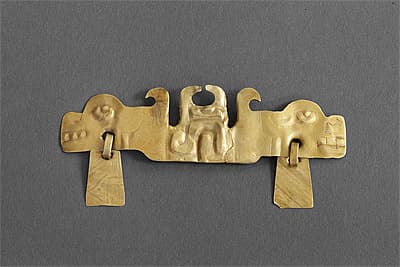CUPISNIQUE culture North coast 1000 BC – 200 BC
Nose ornament 400-200 BC gold , rolling, embossing2.3 (h) x 8.6 (w) cm Ministerio de Cultura del Perú: Museo Arqueológico Nacional Brüning, Lambayeque Photograph: Daniel Giannoni
Early Andean cultures used sophisticated metallurgical techniques to fashion gold and silver into body ornaments to be worn by the living or the dead. Soft grains of gold and small nuggets were heated and rolled into thin sheets, then cut and embossed with complex designs. The crown depicts human heads with feline fangs and snake headdresses. Yellow and black hexagons suggest the markings of jaguars or ocelots and boa constrictors. The large nose ornament bears a snake as well as animal heads.
Early Andean cultures used sophisticated metallurgical techniques to fashion gold and silver into body ornaments to be worn by the living or the dead. Soft grains of gold and small nuggets were heated and rolled into thin sheets, then cut and embossed with complex designs. The crown depicts human heads with feline fangs and snake headdresses. Yellow and black hexagons suggest the markings of jaguars or ocelots and boa constrictors. The large nose ornament bears a snake as well as animal heads.
Early Andean cultures used sophisticated metallurgical techniques to fashion gold and silver into body ornaments to be worn by the living or the dead. Soft grains of gold and small nuggets were heated and rolled into thin sheets, then cut and embossed with complex designs. The crown depicts human heads with feline fangs and snake headdresses. Yellow and black hexagons suggest the markings of jaguars or ocelots and boa constrictors. The large nose ornament bears a snake as well as animal heads.


